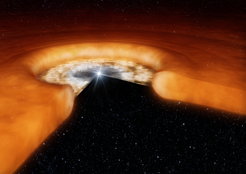Winds of Baby Stars
The origin of gas emission in the innermost region around young stellar objects

An international team of astronomers led by Stefan Kraus from the Max Planck Institute for Radio Astronomy in Bonn, Germany, and Eric Tatulli from the Observatoire de Grenoble, France, used the unique capability of the VLT near-infrared interferometer, coupled with spectroscopy, to probe the gaseous environment of a specific type of young stars called Herbig Ae/Be stars. These are young stars of intermediate mass (approximately 2 to 10 solar masses) which are still contracting and which often show strong line emission.
In recent years, young stars have been widely studied with near-infrared interferometers, allowing astronomers to study their close environment with high spatial resolution. "But so far, near-infrared interferometry has been mostly used to probe the dust that closely surrounds young stars," says Eric Tatulli. "However, dust is only one percent of the total mass of the discs, while gas is their main component and may define the final architecture of forming planetary systems."
High-resolution observations of emission spectral lines are required to trace this gaseous component. Various processes have been proposed as the source of emission lines. For example, the emission lines might come from an accreting gaseous inner disk or might be due to magnetospheric accretion processes or a stellar wind. Most of these processes take place close to the star (less than 1 AU, or the distance between Earth and the Sun) and are therefore not accessible with direct imaging facilities.

Using the ability of the VLTI and the AMBER instrument allowed the astronomers to see details equivalent to the dot at the end of this sentence from a distance of 1000 kilometres and, thus, to study the inner gaseous environments of the six young stars with unprecedented resolution.
"Until now, the origin of the gas emission from these young stars was still debated, because in most earlier investigations of the gas component, the spatial resolution was not high enough to study the gas distribution close to the star," says Stefan Kraus. "The researchers had very different ideas about the physical processes traced by the gas. By combining spectroscopy and interferometry, the VLTI now gives us the opportunity to distinguish between the physical mechanisms responsible for the observed gas emission."
The team measured the geometry and position of the emitting regions surrounding these stars for several diagnostic emission lines. In two of the stars, the emission lines are probably associated with mass infall, either originating within a dust-free, hot gaseous disk or within a very compact emitting region, through which the material is transported from the disk to the stellar surface. For the other four target stars, the line emission seems to be related to mass outflow, with gas lifted from the surface of a circumstellar disk and then ejected from the stellar system.
"Future observations using VLTI spectro-interferometry will allow us to determine both the geometry and motion of the gas and might reveal whether the observed line emission is caused by a jet launched from the disk or by a stellar wind", concludes Stefan Kraus.

